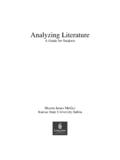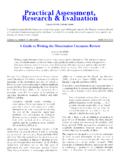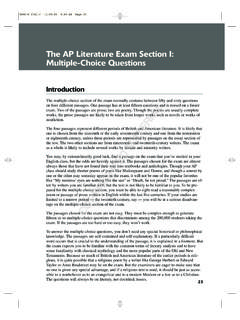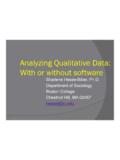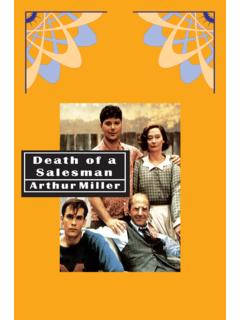Transcription of ANALYZING THE US RETAIL WINE MARKET USING …
1 ANALYZING THE US RETAIL wine MARKET USING PRICE AND CONSUMER SEGMENTATION MODELS (REFEREED) Susan Cholette, San Francisco State University, USA Richard M. Castaldi, San Francisco State University, USA Abstract Globalization and other driving forces have dramatically altered the competitive landscape of the wine industry. Winery managers must understand how these changes can affect pricing and product strategies at the RETAIL level. The objectives of this research effort are threefold. First, the traditional industry price segmentation model will be revised in order to incorporate current industry developments arising from these driving forces.
2 Second, the revised price segmentation model will be used in conjunction with a consumer behavior segmentation model to analyze the US RETAIL wine MARKET . These two segmentation models are analytical frameworks that winery managers can use to identify MARKET opportunities and to assist them in the formulation of their product and pricing strategies in the highly competitive US marketplace. Third, these two segmentation models will be also used to explore the industry ramifications from a hypothetical MARKET scenario for 2008. Introduction The US wine industry is large, expanding, complex and highly fragmented in regard to competition and consumers alike.
3 Tens of thousands of different brands from wine producing regions around the world compete at RETAIL prices ranging from under $2 to over a thousand dollars. Moreover, US consumers run the gamut from tentative neophytes and occasional purchasers to devoted wine connoisseurs. To understand the strategic and competitive dynamics of the marketplace both product price points and buyer behavior patterns need to be studied. Two segmentation models that incorporate conceptual frameworks representing pricing and consumer behavior patterns will be used to analyze the current US RETAIL wine marketplace.
4 Moreover, a future scenario of the MARKET will also be proffered. 1 A nine-point price segmentation model is presented that improves upon the traditional four or five-point models commonly used in trade and academic publications. This revised model includes three broad product super segments, each including three sub-categories with corresponding price points. Interviews with industry experts and executives suggest that these nine product price points and segment classifications more accurately reflect the RETAIL US wine marketplace in 2005. In regard to segmentation and analysis of the US MARKET by consumer behavior patterns, a model created by Moulton et al in 2001 will be applied and extended.
5 While this research draws upon data and findings from over 25 different sources, the data predominately comes from four well-established contributors: Adams Beverage Group (2004), Gomberg-Fredrikson & Associates (2003), MKF Research (2004), and the wine Institute (2004). The US MARKET is the focus of this paper because 1) it is one of the largest global wine markets, 2) it has experienced significant growth in recent years, 3) it has great potential for continued growth and 4) the US is both a major wine producer, as well as a key target MARKET for importers from the Old and New World alike.
6 Extensions of these segmentation models to RETAIL wine markets in other countries is feasible, but beyond the scope of this research effort. The objectives of this research effort are threefold. First, the traditional industry price segmentation model will be revised in order to incorporate current industry developments arising from globalization and other driving forces. This revised nine-point price segmentation model is better suited for firms, trade associations and industry experts in their efforts to collect and analyze RETAIL wine data. Second, the revised price segmentation model will be used in conjunction with a consumer behavior segmentation model to analyze the US RETAIL wine MARKET with the most recent data available.
7 These two segmentation models are analytical frameworks that winery managers can use to identify MARKET opportunities and to assist them in the formulation of their product and pricing strategies in the highly competitive US marketplace. Third, the combination of these two segmentation models will be also used to construct a hypothetical MARKET scenario for the US wine industry in 2008 based on projected consumer trends. 2 AVERAGE US CONSUMPTION AND PRICE TRENDS The US MARKET was third among all countries in total overall wine consumption, at billion liters in 2001.
8 As shown in Table 1, wine consumption has been increasing in recent years. However, the US per capita consumption was only liters in 2001, ranking the US 34th in the world ( wine Institute, 2004). Table 1 shows that per capita consumption is on the rise, but at these rates, the US has decades before reaching the current per capita levels of countries with wine -focused cultures like France (60 liters/year) or Italy (52 liters/year). While several categories of wine exist such as table, coolers, sparkling, dessert and fortified, table wine accounts for about 80% of all wine products sold nationally (Adams Beverage Group, 2004).
9 Other industry research shows table wine purchases totaled billion liters, or a 89% share of all wine products sold in 2003 ( wine Institute, 2004). Although not in complete agreement, both sources show that table wines dominate wine sales, and this research will focus on this category. Table 1: US wine Consumption, All Categories Year Total Consumption Per Capita Consumption1997 billion liters liters/yr 1998 1999 2000 2001 Source: wine Institute, 2004 wine consumption can also be measured by revenue as well as volume.
10 Figure 2 shows that, after adjusting nominal prices to account for inflation, real wine prices have slowly been rising over the past few decades. While wine prices in recent years have been relatively stable, averaging just over $7 per 750ml bottle equivalent, they are higher than the $6/bottle average experienced 15-20 years ago. This upward trend over time is strong, with a correlation of .83. While rising prices for some products might be attributed to scarcity, either natural or monopoly-induced, such is not the case with wine , which has thousands of producers and has been in oversupply for much of recent history (Cholette, Castaldi and Fredrick, 2005).
